Sapphire Pulse Radeon RX 6600 XT review - carvajalyoughtley

Brad Chacos/IDG
At a Glimpse
Expert's Rating
Pros
- Fantabulous, speedy 1080p gambling
- Trixx Boost can make performance a good deal faster
- Cool, real quiet tradition design
- AMD features like FSR, Radeon Supercharge, Cagey Access Memory can make information technology faster
- Passably human-sized, just a hair over 2 slots
- Laser-cente good performance and cooling
Cons
- Very, very up MSRP for a 1080p card
- Zero extra features corresponding BIOS switch operating theatre RGB lighting
- 1440p performance International Relations and Security Network't as proud ascribable memory setup (but Trixx Boost helps)
- Radiate tracing lags behind Nvidia's performance
Our Verdict
The Sapphire Pulse Radeon RX 6600 XT is a simple, univocal graphics card that focuses on good cooling and superior performance, aided by a killer Trixx Encouragement software feature. It's a great 1080p play option if you're willing to pay general pricing for a GPU.
Best Prices Today

$399
Sometimes simple is better.
The Radeon RX 6600 XT graphics cards we've reviewed so far—the $550 Asus ROG Strix, and the $419 XFX Speedster Merc 308—represent the pinnacle of those manufacturers' lineups, bristling with heavy-duty coolers and fancy extras like plural-BIOS switches and glittering lights. And yes, both designs impressed. But the $399 Sapphire Pulse Radeon RX 6600 XT takes the opponent tack, cutting out the fat to pore entirely on delivering good performance and good temperature reduction at a keen price. (In principle, at least, since the crippling GPU shortage means art card prices rocket the second they hit store shelves.)
Don't let that fool you, though. Even though the Sapphire Pulse lacks fanciful ironware luxuries, IT manages to win of those pricier Radeon RX 6600 Crosstalk models in our benchmark tests—and it's because of software. Sapphire has spent age honing its "Trixx Boost" feature, which marries slight image upsampling with AMD's Radeon Figure of speech Sharpening technology to superior performance-boosting event. Activating Trixx pours happening unneeded frames, and to a large enough extent that the Pulse delivers solid 1440p gameplay in titles that can give other Radeon RX 6600 XT models some fits.
So yes, the ironware is only part of the report for the Sapphire Pulse Radeon RX 6600 XT. Countenance's stab in.
Sky-blue Pulse Radeon RX 6600 XT glasses, features, and design
Cost sure to sound out our original Radeon RX 6600 XT review for a deeper discourse around this GPU's frame-up. It's worth the time if you're a chip wonk. AMD's RDNA 2 architecture helps the Radeon RX 6600 XT sip power and off flip-high clock speeds, just technical details nearly how this GPU's Infinity Cache was enforced—and mated with a petite memory bus—means it is advisable suited for ultra-straightaway 1080p gaming than stepping capable 1440p. (Cerulean's Trixx Encouragement tech makes that less true for the Pulse, at least for today.)
For this review, we'll rightful plonk a chart below that shows how the Radeon RX 6600 XT's describe specifications push-down stack up against last generation's $279 Radeon RX 5600 XT and $400 Radeon RX 5700 XT. They're likely comparisons, because while the new menu power carry the 5600 XT's lineage, information technology too comes in at the 5700 XT's higher toll go after.
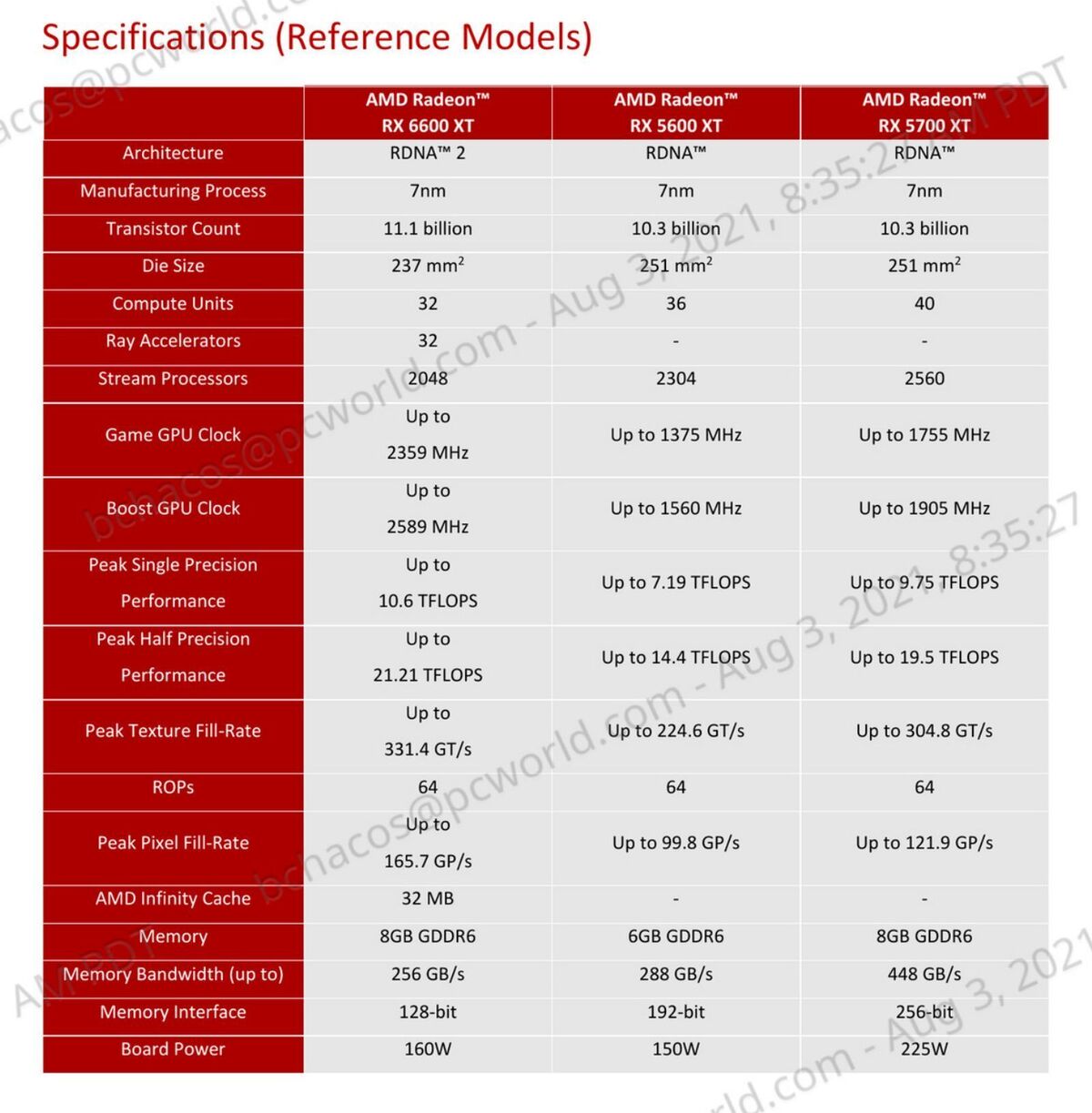 AMD
AMD In comparison, the Pulse doesn't change up too much aside from one key spec: Clock speeds. Sapphire bumped the typical Game Log up to 2,382MHz from the default 2,359MHz. That's a modest increase, and behind the 2,428MHz we saw in the pricier 6600 XT models, but as you'll see in our benchmarks, these all deliver essentially superposable performance in their stock configurations. Plus, Azure needful to leave its step-risen $450 Nitro+ oblation some room to work.
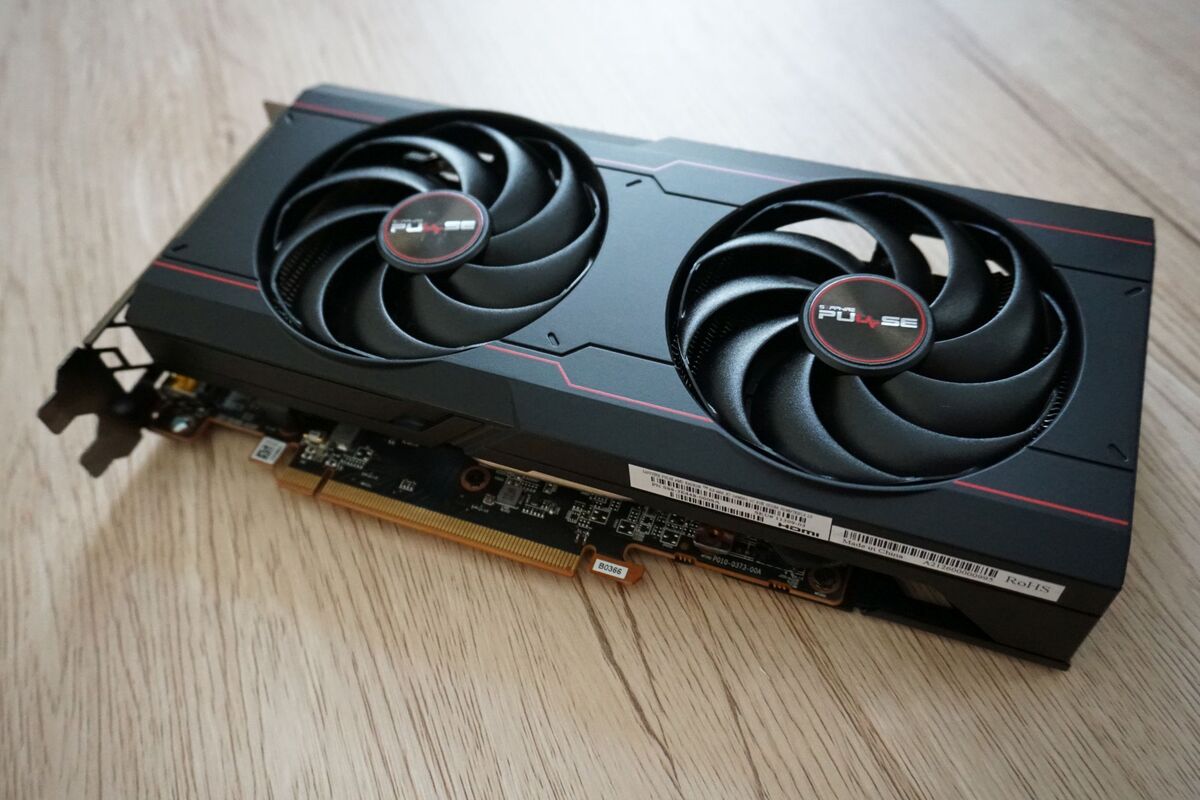 Brad Chacos/IDG
Brad Chacos/IDG Sapphire left all the garnished extra features to the Nitro+ as well. The Pulse RX 6600 XT sticks to a plain, black innovation with around red Pulse and Radeon branding, simply nary an RGB LED, exchangeable fan, operating room dual-BIOS switch in sight. Put on't mistake plainness for ugliness, however, as the simple enhancive should fit very healed in most play PCs. An aluminum backplate atop the graphics card keeps things sounding nice and clean, spell the black shaping shroud includes some light texturing that helps it look Sir Thomas More attractive.
 Brad Chacos/IDG
Brad Chacos/IDG Piece it's non loaded down with heavy metal, the Pulse doesn't skimp connected the cooling front either. A standard-sized heatsink supports the GPU and other vital components, working in alignment with Cerulean's "crossbreed fan design" that we first witnessed in the Nitro+ Radeon RX 6800 XT. The spick-and-span crossed fan blades merge characteristics from some axile and blower-style fans, improving both airflow and air pressure compared to yesteryear's axial fans, piece keeping noise levels low. The 2 fans connected the Pulse each comes squiffy with nine of the shallow, swooping blades, compared to twelve on the Nitro. Cut-outs in the backplate help air flow clean through the heatsink.
It's straightforward but effective—a cornerstone for the Pulse series. Sapphire's card manages to run near inaudibly piece safekeeping temperatures well tamed, with characteristics similar to the fantastic customs duty ice chest on XFX's contende Merc 308 Radeon RX 6600 XT. That's especially impressive when you consider that the XFX sports a big, monthlong cooler, and the Pulse measures in at just a whiske over 2 slots slurred. Good stuff.
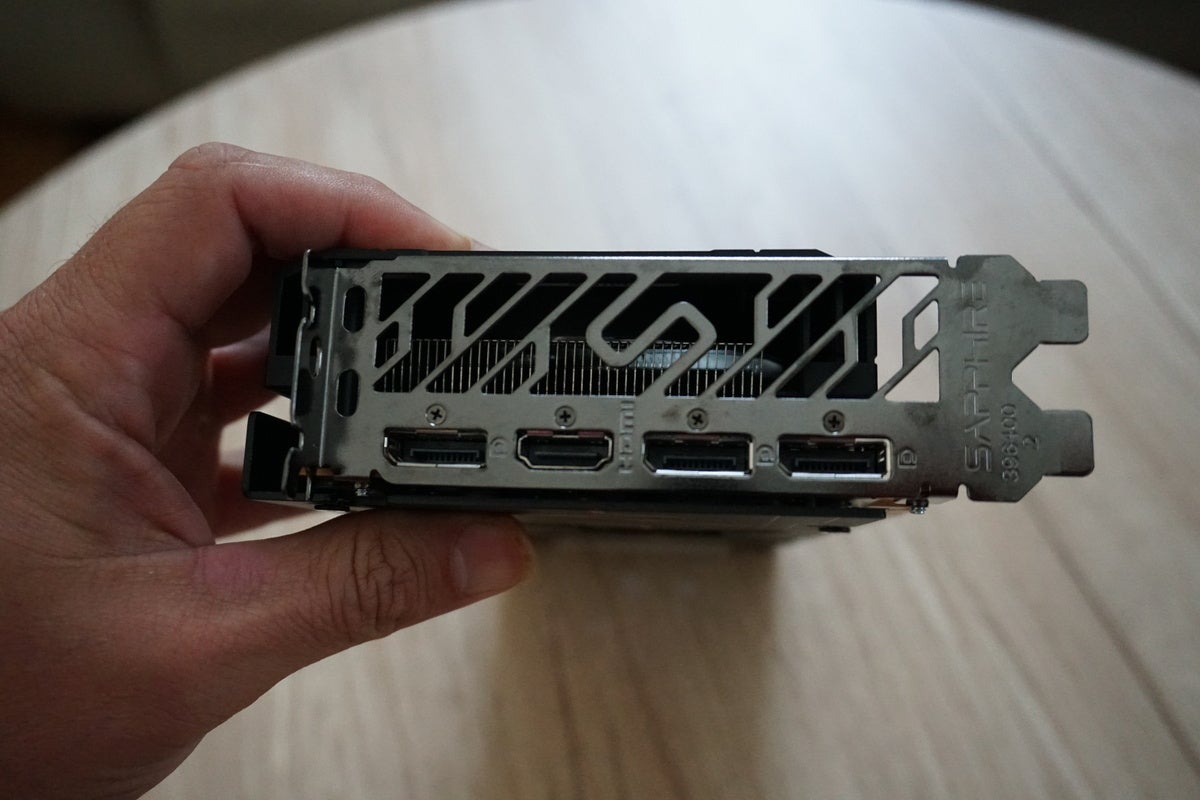 Brad Chacos/IDG
Brad Chacos/IDG Port report
Speaking of good stuff, like other RX 6000-series GPUs, XFX's take over the RX 6600 XT supports every of RDNA 2's various features, including FidelityFX Super Resolution and Smart Access Memory to boost performance, real-time ray tracing capabilities, AV1 video recording decoding, DirectX 12 Ultimate goodies, an improved version of Radeon Further that wraps in Variable Rate Blending, Radeon Anti-Lag across every major DX APIs, FreeSync display bear, AMD Link streaming to other devices, and much more. AMD's robust Radeon Settings app includes both manual and automatic carrying out tuning controls, so you can tweak the card to your heart's extent with those duple BIOS profiles.
And Sapphire's possess tailored software package solution adds so much more.
Next page: Lazuline Trixx Boost
Sapphire Trixx Boost
Like all Sapphire nontextual matter card game in the RDNA ERA, the Pulse RX 6600 XT supports Trixx Boost, a cagey boast that speeds up frame rates using a combining of flimsy image downsampling and AMD's wonderful Radeon Figure of speech Sharpening engineering science. It's like a less complex version of the idea slow Nvidia's DLSS and AMD's new Faithfulness FX Super Resolution features: Give at a lower declaration to improve figure rates, then tidy the resulting image artifacts with the help of smart software system.
We'rhenium surprised that other GPU makers haven't ripped off the idea, frankly. Trixx Boost has helped Sapphire GPUs earn postgraduate First Baron Marks of Broughton in our reviews for several years now—it earned the "best innovation" award on our Full Nerd podcast's yearly best-of episode the whole way back in 2019—and doesn't rely on any inner technologies. Alternatively, information technology helps several existing technologies that can be activated via composite manual methods work together in a easy-to-understand interface. Its secret sauce is simplicity.
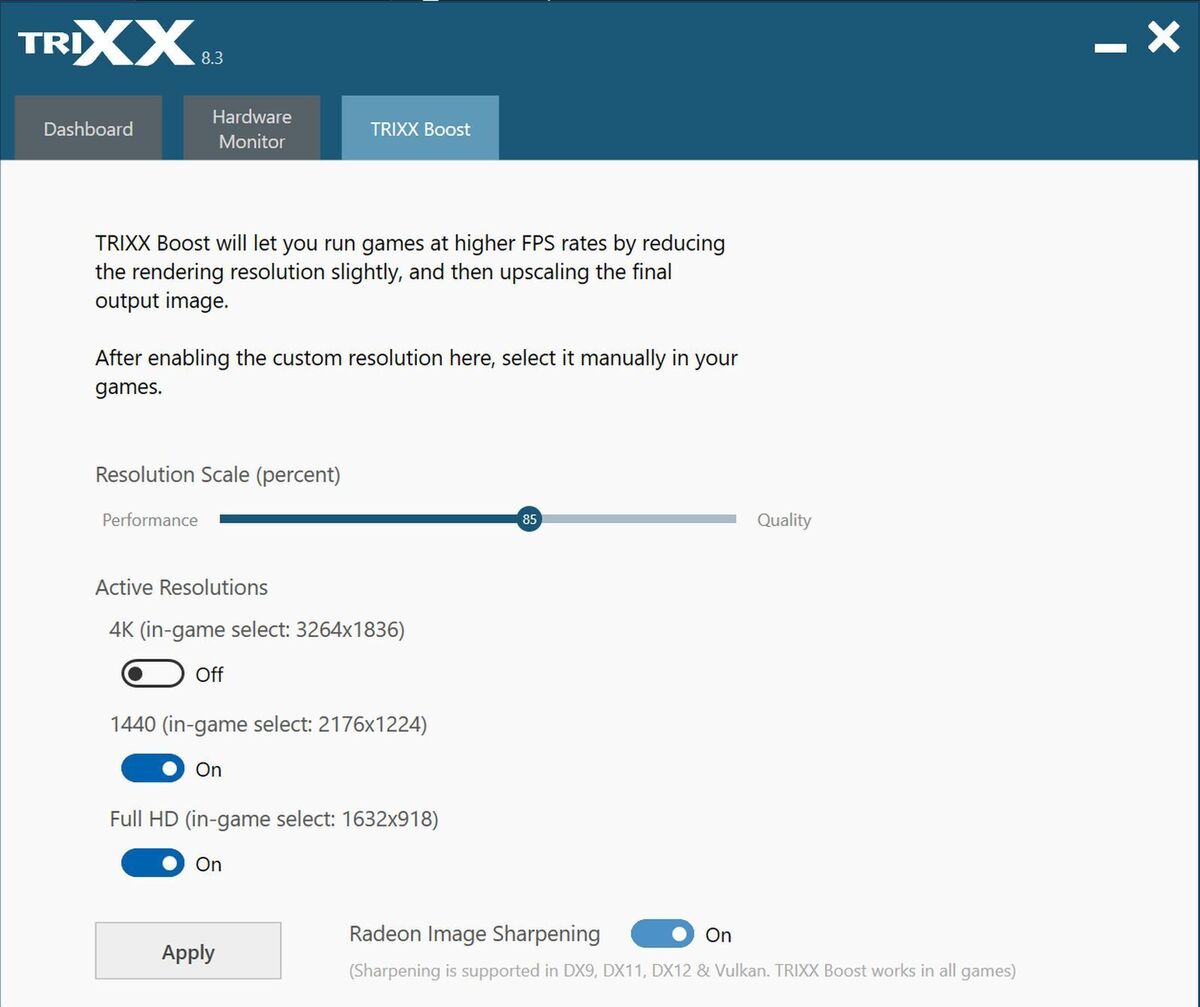 Brad Chacos/IDG
Brad Chacos/IDG The Trixx Rise tab in Azure's software.
Better however, patc Nvidia DLSS kit and caboodle with only a couple of cardinal games, and AMD's infant FSR works in under cardinal, Trixx Boost works with any DirectX 9, DX11, DX12, or Vulkan game. That covers near the nigh niche PC games being played today.
You'll need to establis Azure's overarching Trixx software retinue (which also includes features like hardware monitoring and devotee health checks, depending on your GPU) to use Boost. And yes, despite the similar-full make, Trixx Encourage and AMD's Radeon Boost are two very different technologies with very different use cases, though some require modern Radeon GPUs. You can level usance them collectively.
Trixx Boost creates custom display resolutions for your display, scaled down in customizable 5-percent increments all the direction down to 50 percent. Rendering at a lower resolution percentage gives you a corresponding performance bump, so using 80 percent on the scaling slider testament deliver faster performance than using 90 percent of your native resolution. (The performance increase can vary from game to game, however.) You arse as wel choose to activate AMD's Radeon Epitome Sharpening feature to reduce the shimmering that can be introduced by track at less-than-native resolutions—and you definitely should, as IT can greatly help with picture quality.
 Brad Chacos/IDG
Brad Chacos/IDG Lazuline's utility will warn you your concealment may flitter, and then your screen testament flicker.
Play around thereupon resolution slider a bit though, specially at the 1080p resolution that the Radeon RX 6600 XT works first at. Trixx Boost defaults to a tradition resolution at 85 percentage of your native screen output. That kit and boodle wonderfully well when you'ray performin at to a greater extent pixel-packed 1440p and 4K resolutions when paired with RIS, only subjectively, I found it too aggressive at 1080p. The glower firmness of purpose means that cutting it back even more results in shimmering and occasionally janky edges that are really perceptible in motion at 85 percentage. (This isn't just a Trixx Hike publish; both DLSS and FSR too have troubles maintaining image quality at 1080p resolution, but not at higher faithfulness.)
I found it much more pleasant to bump the microscope slide up to 90 percent of the screen door settlement for 1080p gameplay, indeed those are the settings we'll use in our benchmark results today. (I left the 1440p scaling set at 90 percentage for the saki of simplicity too, though that answer whole caboodle alright at 85 percent grading by my eye.) IT tranquillise isn't quite idyllic; you may still see slight exteroception artifacts in some scenes, such as sick shimmering on narrow stairs in motion, or faint softness in static menu screens contingent their setup. Simply those distractions proved few and immoderate betwixt at 90-percent scaling in my opinion, and the extra performance provided by Trixx Boost made the episodic coarseness worthy. If you disagree, you can ever stop using it.
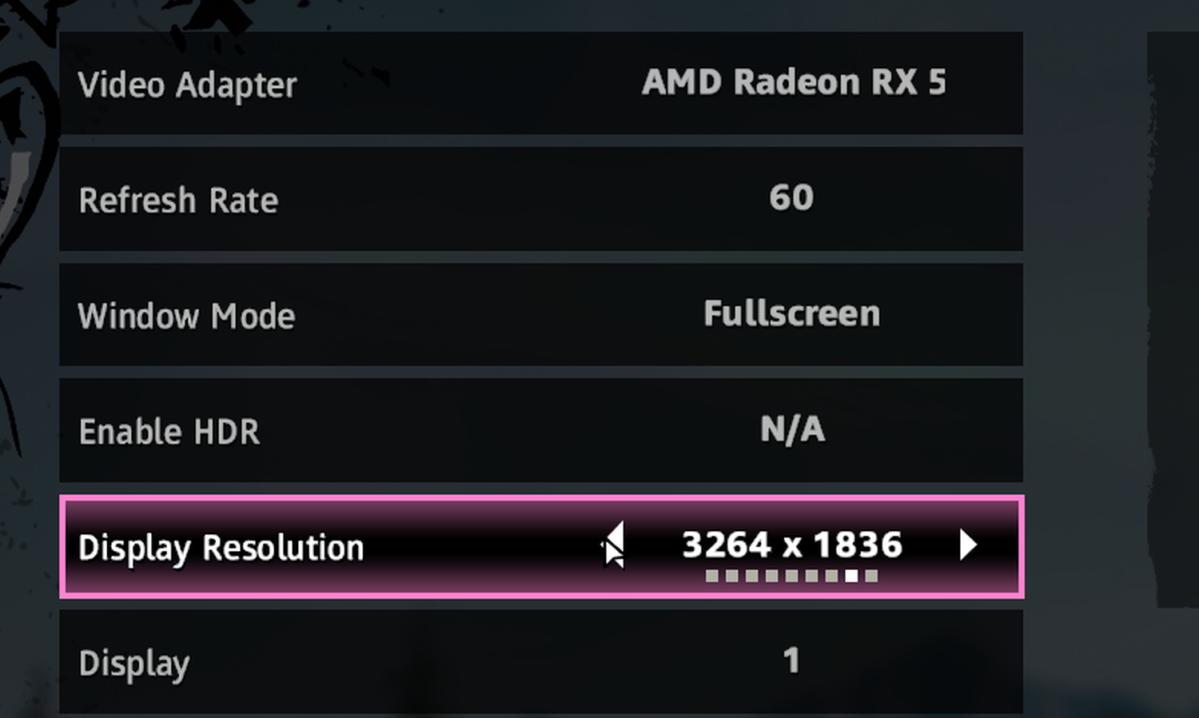 Brad Chacos/IDG
Brad Chacos/IDG Screenshot of a custom resolving created using Sapphire's Trixx Boost software package.
One final mark: You need to select the custom resolution manually in-plot to take advantage of Trixx Boost. Simply selecting the 1080p or 1440p resolutions you're accustomed doesn't work. Instead, go into the spunky's graphical or display options menu and pick the resolution that Boost created at your chosen scaling percentage. Fortunately, the Trixx Boost tab in Sapphire's software shows you the exact custom closure when you create it, as you can see in the screenshot supra. You can always hold up back to that for consultation if you forget the particulars.
Let's nark benchmarking!
Succeeding page: Our test system, benchmarks begin
Our test system
Our AMD Ryzen 5000-serial publication test rig tin benchmark the effect of PCIe 4.0 support on modern GPUs, American Samoa well as the functioning-boosting AMD Smart Access Memory and Nvidia Resizable Block u features (which are both based on the cookie-cutter underlying PCIe standard). Currently, we're testing it connected an coarse Bench with AMD's Wraith Max zephyr tank; in the future, we'll add an NZXT Kraken liquid ice chest to the combine. Most of the hardware was provided away the manufacturers, simply we purchased the reposition ourselves.
- AMD Ryzen 5900X, stock settings
- AMD Wraith Max tank
- MSI Godlike X570 motherboard
- 32GB G.Skill Trident Z Neo DDR4 3800 retentiveness
- EVGA 1200W SuperNova P2 power supply
- 1TB SK Hynix Golden S31 SSD
We'Re comparison the $399 Lazuline Pulse Radeon RX 6600 Crosstalk against the several cards it's replacing either spiritually or practically: The $279 Radeon RX 5600 XT, the $350 Radeon RX 5700, and the $400 Radeon RX 5700 XT, as well equally Asus's spin on this GPU, the $550 ROG Strix RX 6600 XT, and the $419 XFX Speedster Merc 308 Radeon RX 6600 XT. On the Nvidia front, we've included results for the reference-spec'd $330 EVGA RTX 3060 XC Black Gaming too as EVGA's terrible GeForce RTX 3060 Titanium FTW3 Ultra, because this card hovers in the same overall damage range every bit the Atomic number 2 models. All of these suggested prices are a fraction of what you'll yield for these GPUs in the real world right now, course, but using advisable pricing helps evaluate artwork card game Eastern Samoa they were intended.
We essa a variety of games spanning various engines, genres, vendor sponsorships (Nvidia, AMD, and Intel), and graphics APIs (DirectX 11, DX12, and Vulkan). All game is tested using its in-game benchmark at the highest possible graphics presets unless otherwise notable, with VSync, frame value caps, period ray tracing or DLSS personal effects, and FreeSync/G-Sync disabled, on with whatsoever other vendor-specific technologies like FidelityFX tools Beaver State Nvidia Reflex. We've also enabled temporal anti-aliasing (TAA) to push these cards to their limits. We run from each one benchmark at least three times and list the average final result for from each one test.
Equally mentioned in the prior section, we've also included benchmark results with Trixx Cost increase active at 90 percentage scaling of the native cited resolutions, paired with Radeon Image Sharpening. We assume't coiffure that for Nvidia DLSS or AMD's FSR, but Trixx Boost works in most all game available, and information technology's worthy highlighting what it can do, particularly since the Radeon RX 6600 XT can buoy sometimes struggle at 1440p resolve due to its form. Trixx Boost can really help there.
Comprise sure to check unstylish our original Radeon RX 6600 Crosstalk review for so much deeper conversation roughly the GPU's technical prowess and capabilities. We'll be presenting the data without comment here until the end of the brushup. Keep an eye on those Trixx Boost results.
Gaming performance benchmarks
Watch Dogs: Host
Watch Dogs: Hostis one of the first games to debut along next-gen consoles. Ubisoft upgraded its Disrupt engine to include with-it features like period ray tracing and Nvidia's DLSS. We disable those effects for this testing, onlyLegion remains a strenuous game regular along high-end computer hardware with its nonobligatory high-resolution texture pack installed. The stake allocates more than 8GB of memory even at 1440p. Oof.
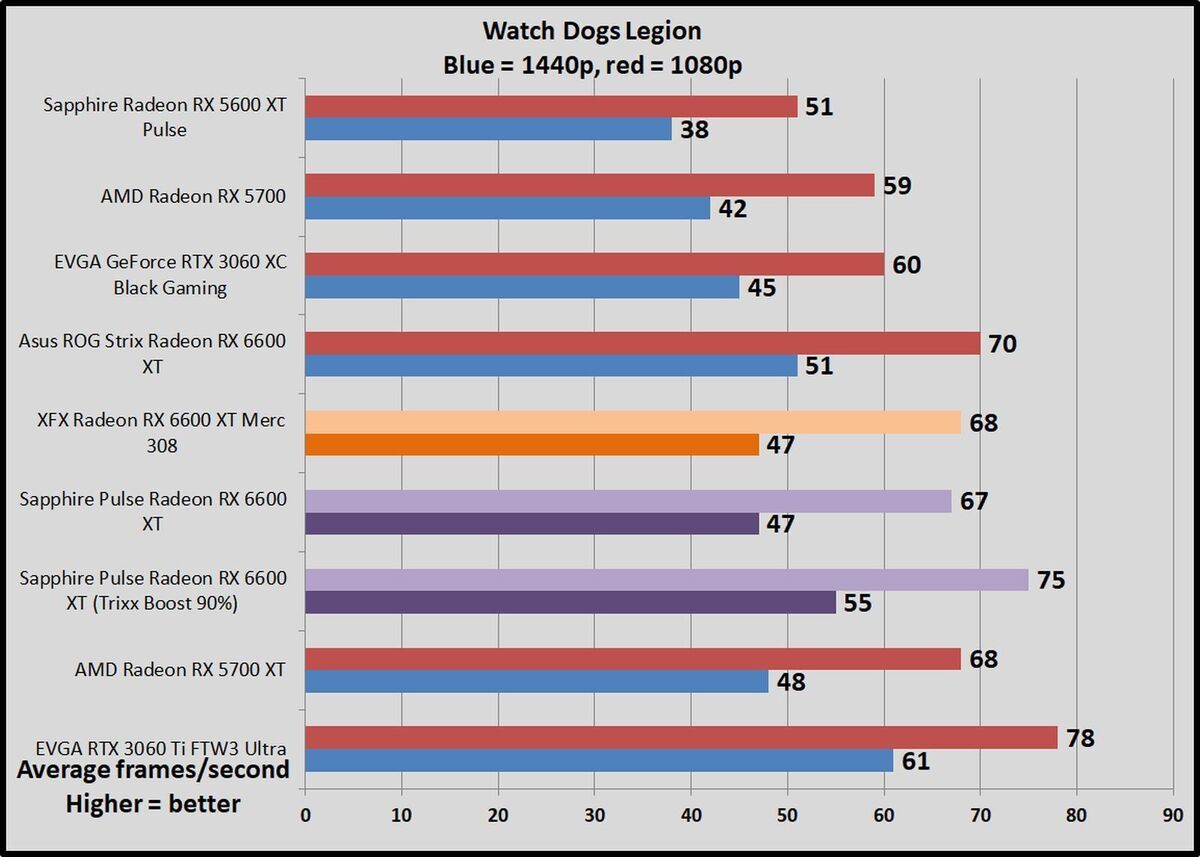 Brad Chacos/IDG
Brad Chacos/IDG Horizon Zero Dawn
Yep, PlayStation exclusives are coming to the PC now.Horizon Cipher Dawn runs connected Guerilla Games' Decima engine, the same engine that powersDeath Stranding.
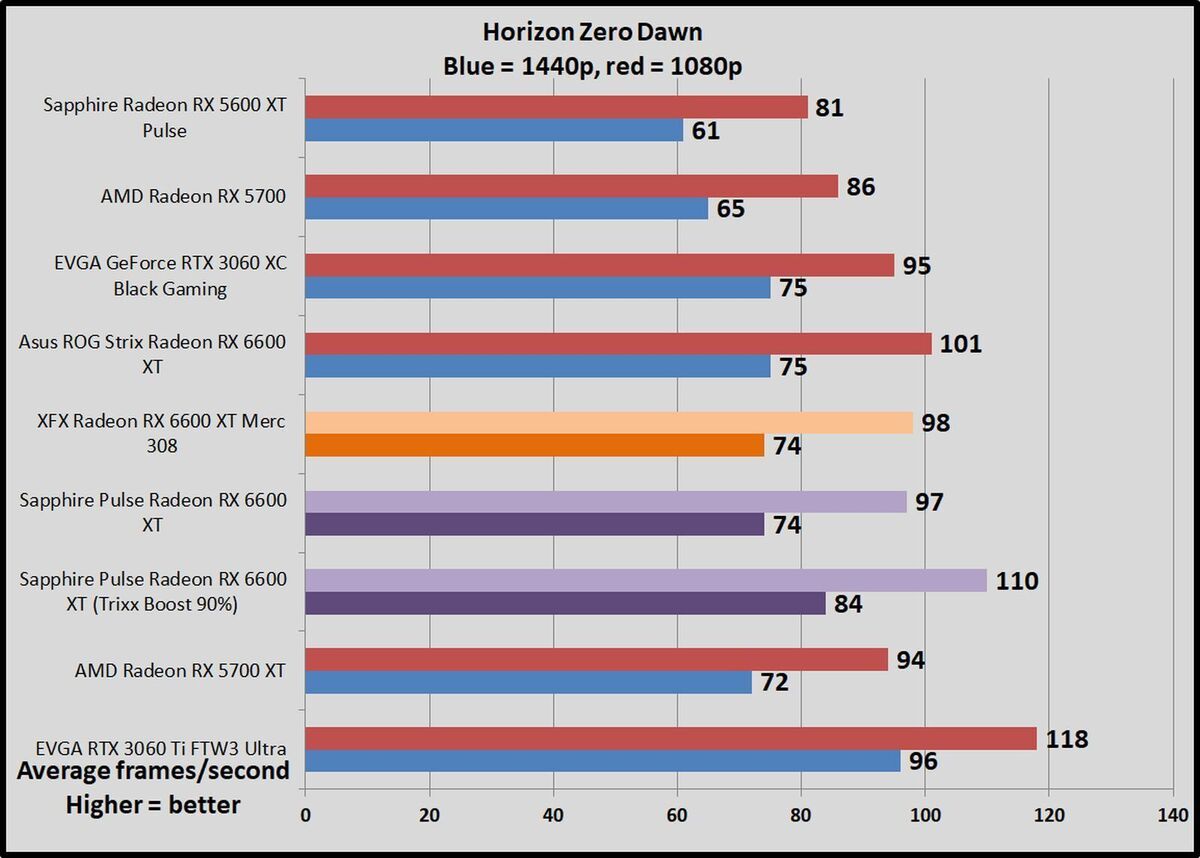 Brad Chacos/IDG
Brad Chacos/IDG Next page: gaming benchmarks continue
Gears Tactics
Gears Tactic puts it own brutal, fast spin connected theXCOM-look-alike genre. This Unreal Railway locomotive 4-supercharged gimpy was made-up from the ground up for DirectX 12, and we love being able to work a maneuver-style game into our benchmarking cortege. Better so far, the game comes with a plethora of graphics options for PC snobs. Much games should devote such loving care to explaining what flipping all these visual knobs mean.
You arse't apply the presets to benchmarkGears Tactics, as it intelligently scales to process best on your installed computer hardware, meaning that "Ultra" on one graphics card can load divergent settings than "Ultra" along a weaker card. We manually set all options to their highest possible settings.
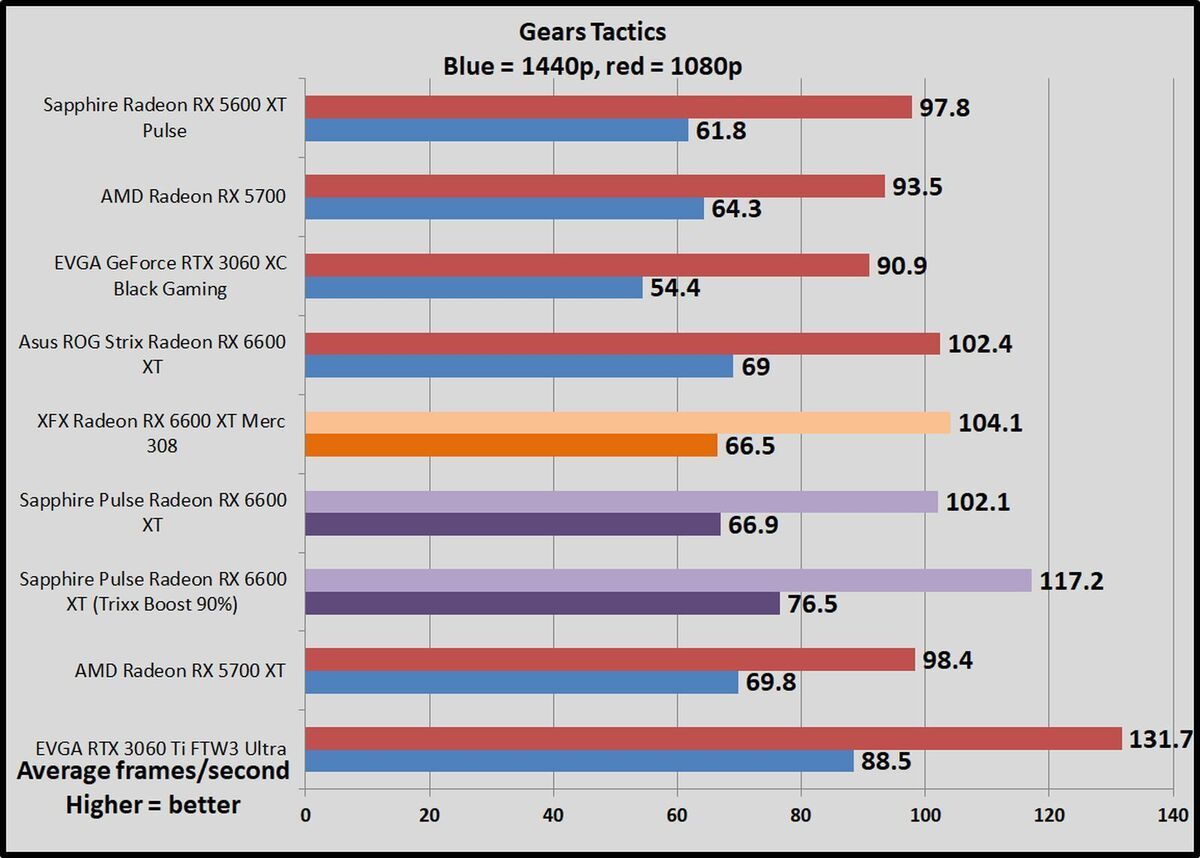 Brad Chacos/IDG
Brad Chacos/IDG Wolfenstein: Youngblood
Wolfenstein: Youngblood is more fun when you can play hand and glove with a chum, but it's a unshrinking experiment—and an absolute technical showcase. Running on the Vulkan API,Youngblood achieves blistering frame rates, and it supports every last sorts of cutting-edge technologies like ray tracing, DLSS 2.0, HDR, GPU culling, asynchronous computing, and Nvidia's Content Adaptative Shading. The game includes a built-in benchmark with two different scenes; we tested Riverside.
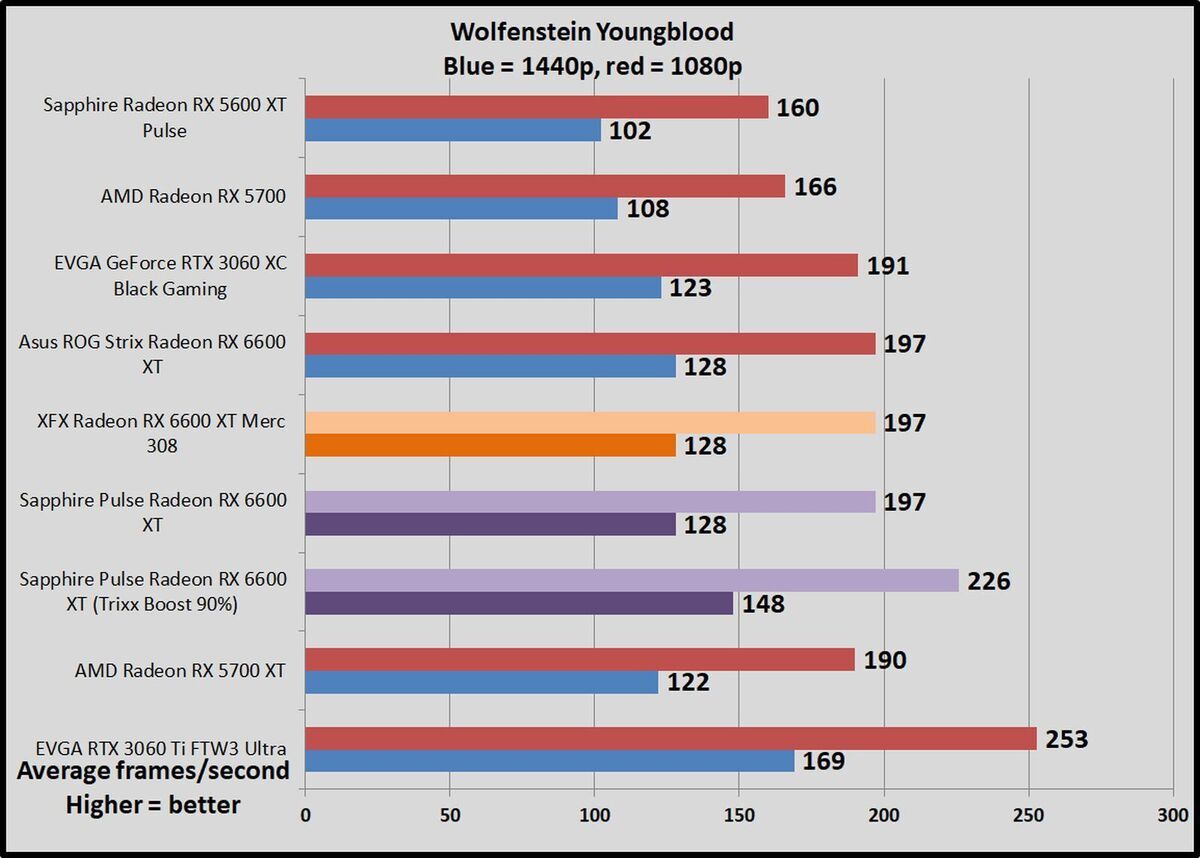 Brad Chacos/IDG
Brad Chacos/IDG Metro Exodus
Matchless of the trump games of 2019,Metro Exodusclay one of the best-looking games around, to a fault. The latest version of the 4A Engine provides incredibly pleasant-tasting, immoderate-detailed visuals, with one of the most stunning real-time ray tracing implementations free all the same. The Intense nontextual matter preset we bench mark can melt smooth the most powerful modern hardware, as you'll see below, though the mettlesome's Ultra and High presets still look away good at much higher frame rates.
We test in DirectX 12 mode with ray of light tracing, Hairworks, and DLSS disabled.
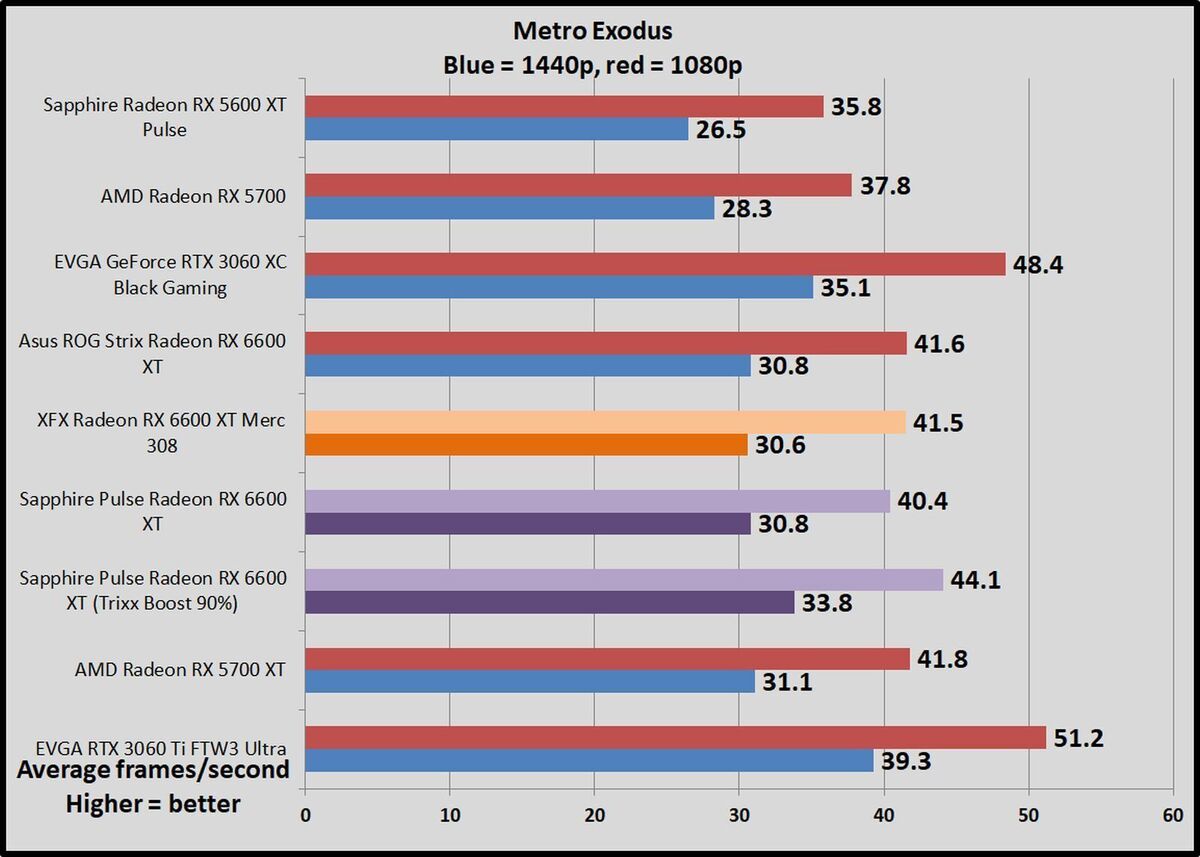 Brad Chacos/IDG
Brad Chacos/IDG Borderlands 3
Borderlands is back! Gear case's game defaults to DX12, thus we do as well. It gives us a glimpse at the ultra-popular Unreal Locomotive engine 4's carrying out in a traditional shooter. This game tends to favor AMD computer hardware.
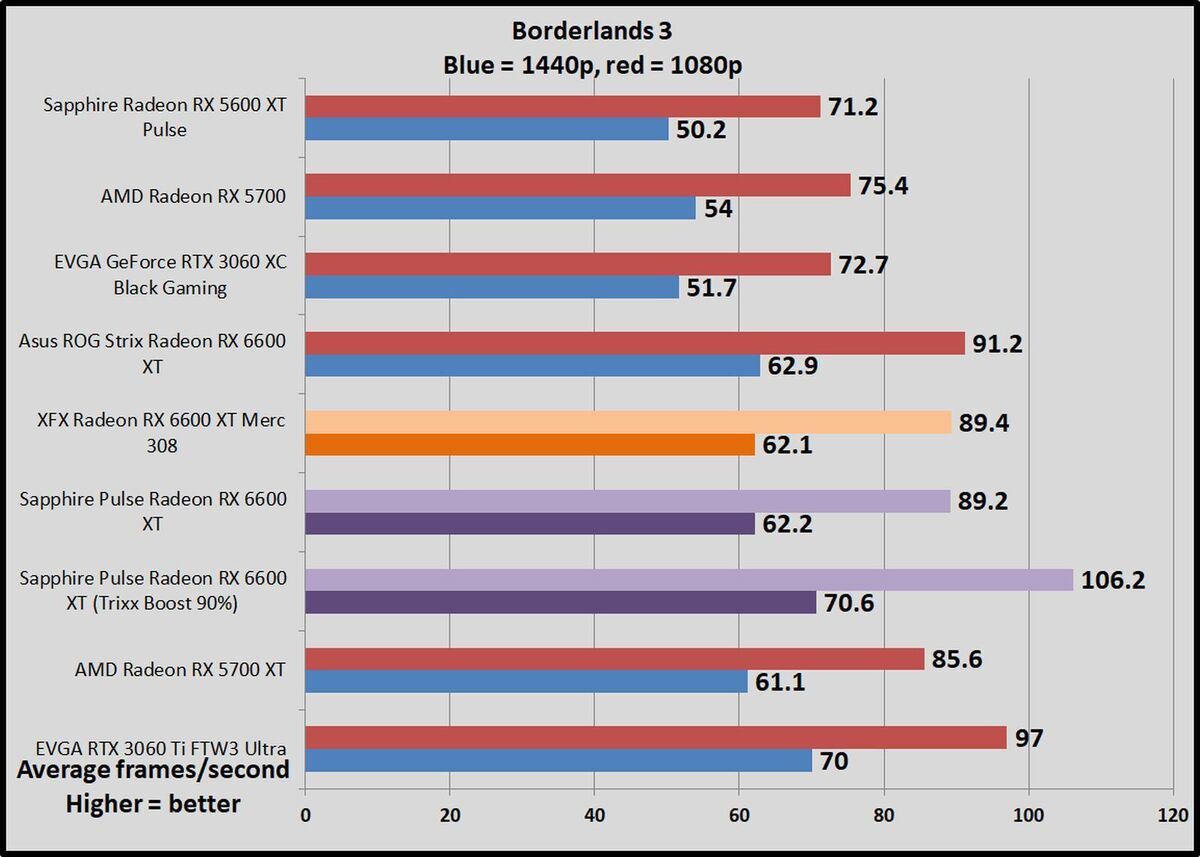 Brad Chacos/IDG
Brad Chacos/IDG Strange Brigade
Strange Brigade is a cooperative third-someone hitman where a squad of adventurers blasts through with hordes of mythological enemies. It's a technological showcase, built around the next-gen Vulkan and DirectX 12 technologies and infused with features like HDR plump for and the ability to toggle switch asynchronous compute on and off. Information technology uses Rebellion's tailored Azure engine. We psychometric test exploitation the Vulkan renderer, which is faster than DX12.
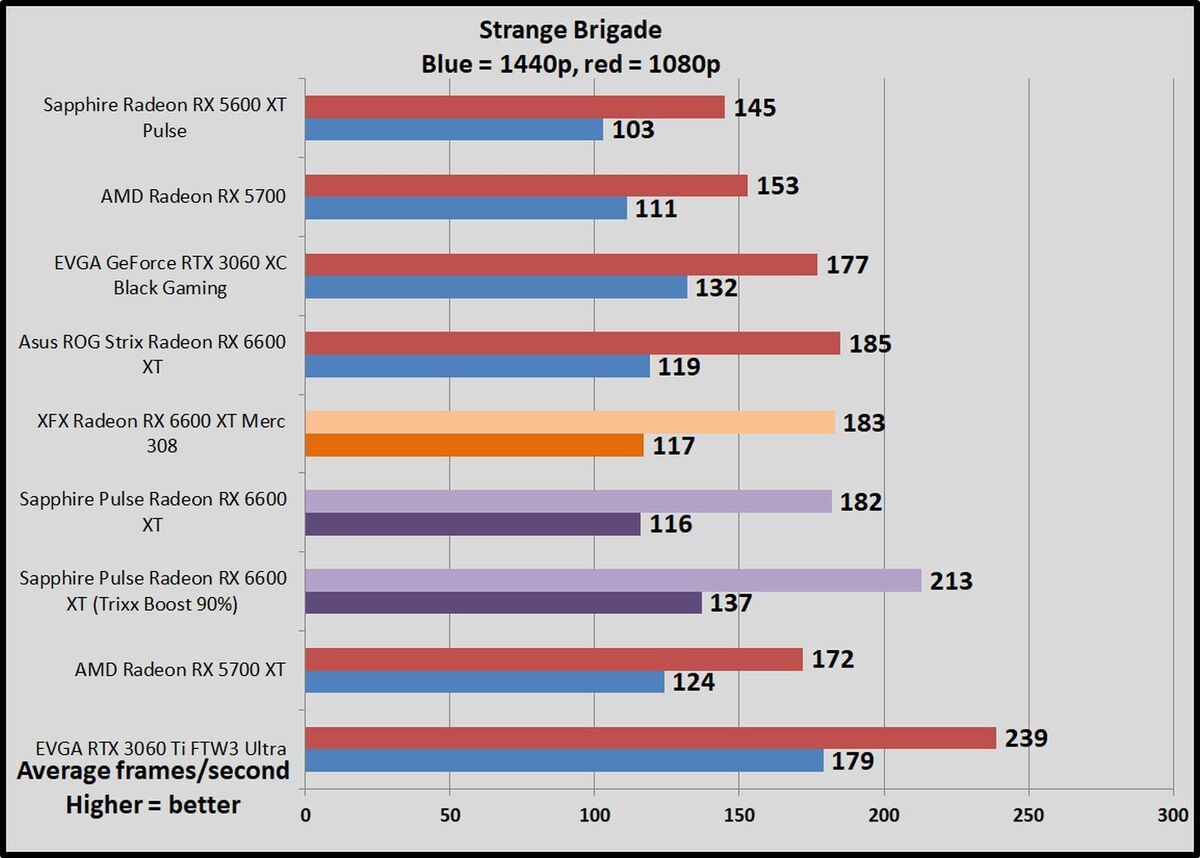 Brad Chacos/IDG
Brad Chacos/IDG Next page: play benchmarks continue
Total War: Troy
The fashionable game in the popularTotal War saga,Troywas given away free for its first 24 hours on the Epic Games Store, moving over 7.5 million copies before it went on proper sale.Total War: Troy is reinforced using a modified version of theCome War: Warhammer 2 engine, and this DX11 title looks arresting for a turn-based scheme game. We test the more intensive battle benchmark.
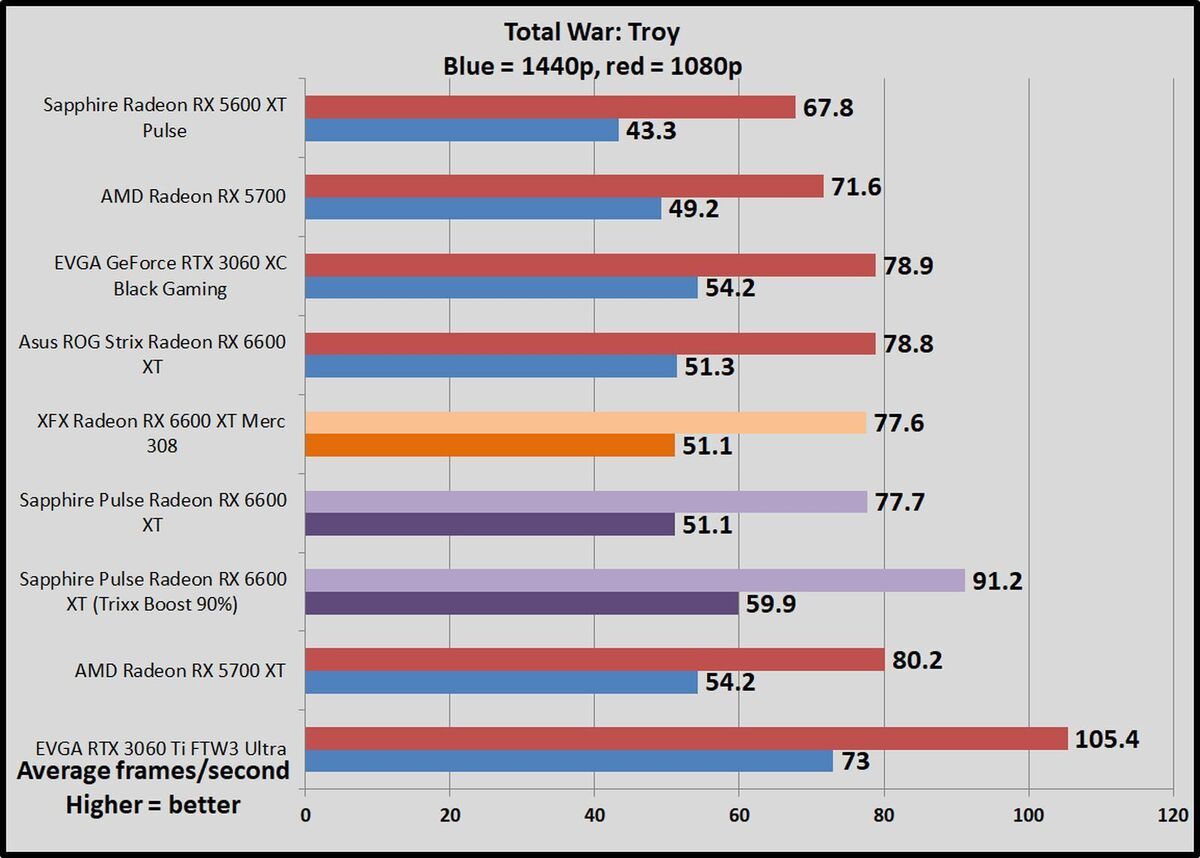 Brad Chacos/IDG
Brad Chacos/IDG F1 2020
F1 2020is a gem to test, supplying a wide array of both graphical and benchmarking options, making IT a much more reliable (and diverting) alternative that theForzaseries. It's built on the latest version of Codemasters' buttery-smooth Ego pun engine, complete with support for DX12 and Nvidia's DLSS engineering. We test two laps on the Australia course, with unqualified skies on and DLSS off.
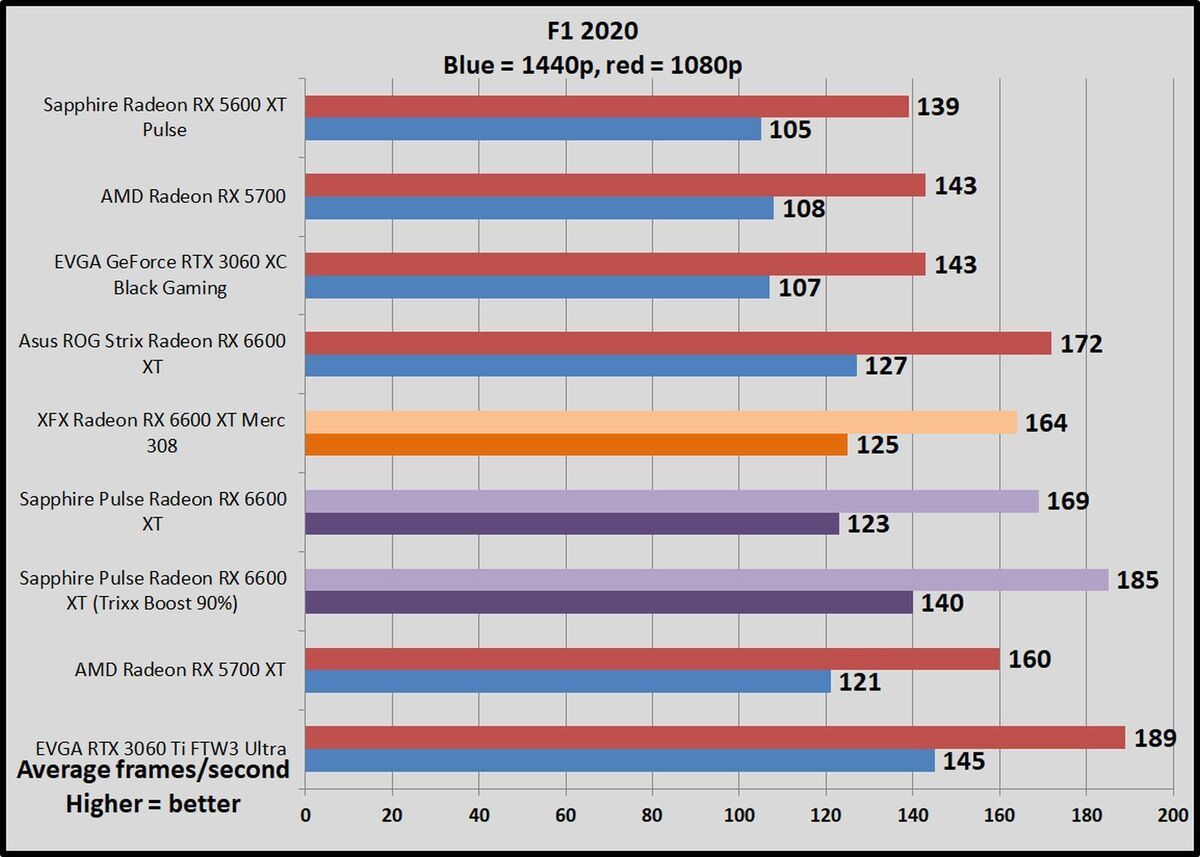 Brad Chacos/IDG
Brad Chacos/IDG Phantasm of the Tomb Pillager
Dwarf of the Grave Pillager concludes the reboot trilogy, and information technology's still utterlybeautiful a duet of years after its debut. Square Enix optimized this game for DX12 and recommends DX11 only when you're using aged hardware or Windows 7, so we test with DX12.Shadow of the Grave Raider uses an enhanced version of the Foundation locomotive that also poweredAscending of the Tomb Raider and includes elective period ray tracing and DLSS features.
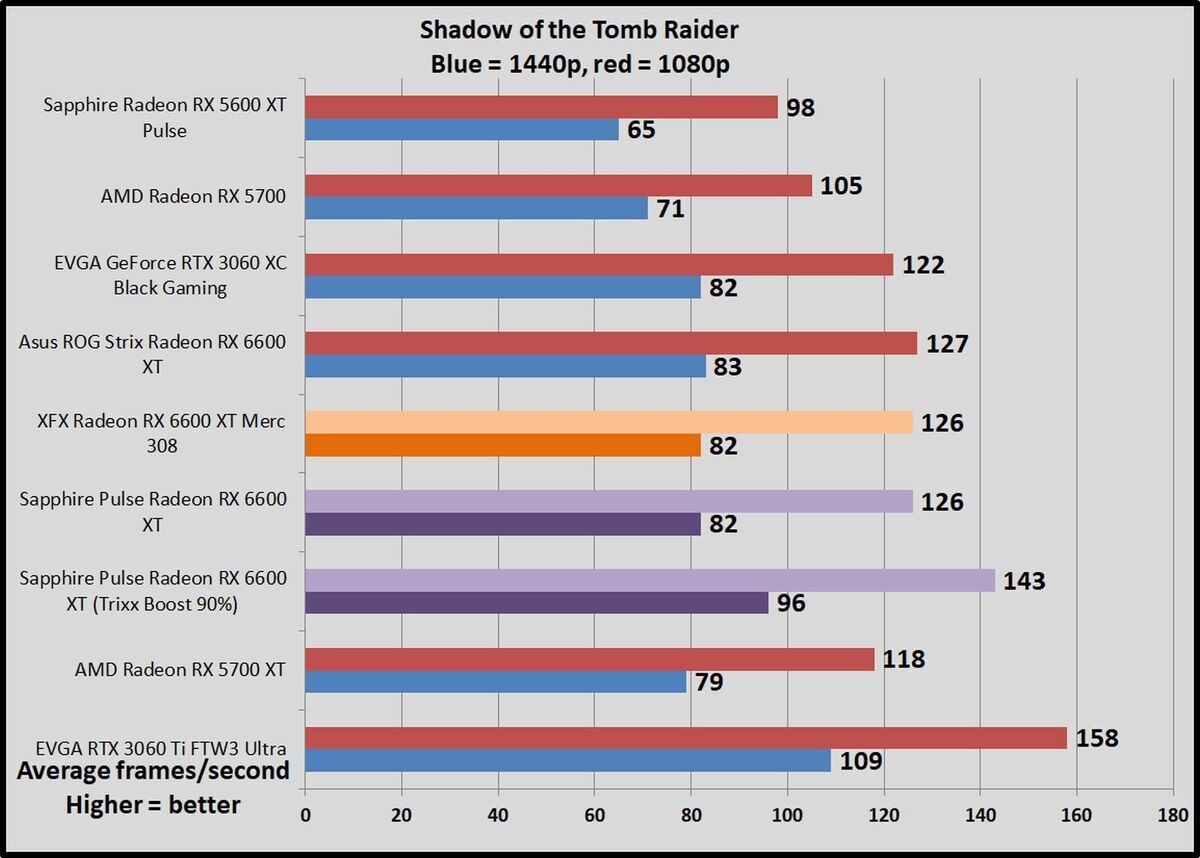 Brad Chacos/IDG
Brad Chacos/IDG Rainbow Six Beleaguering
Rainbow Six Military blockade calm dominates the Steam charts years after its launching, and Ubisoft supports it with frequent updates and events. The developers have poured a ton of work into the game's AnvilNext engine over the years, eventually rolling outer a Vulkan version of the game that we use to test. Aside default, the game lowers the render scaling to increase material body rates, but we set information technology to 100 percent to benchmark autochthonal translation performance happening graphics cards. Even still, frame rates soar.
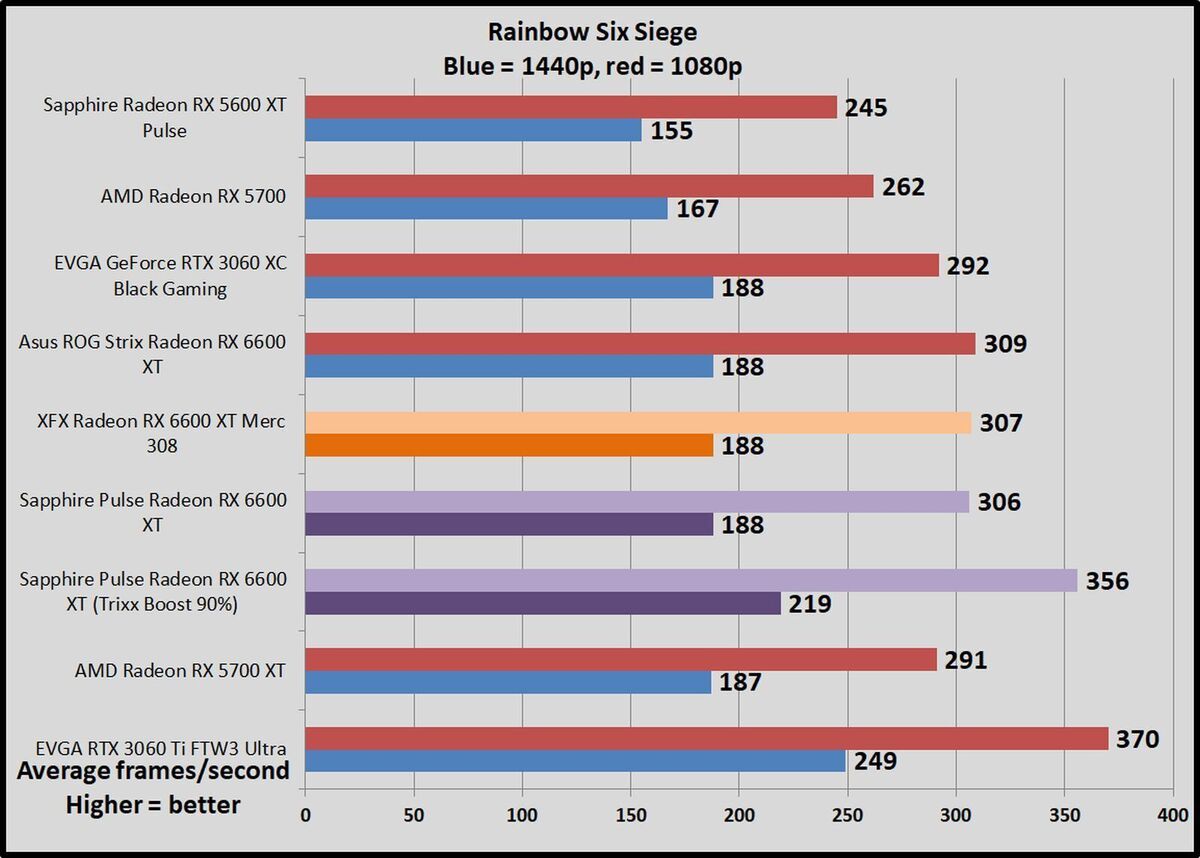 Brad Chacos/IDG
Brad Chacos/IDG Next paginate: Power, thermals, and noise
Big businessman hook, thermals, and noise
We test power draw by looping theF1 2020 benchmark at 4K for about 20 minutes after we've benchmarked everything else and noting the highest reading happening our Watts Up In favour of meter, which measures the power consumption of our integral essa system. The first part of the race, where all competing cars are onscreen simultaneously, tends to equal the most demanding portion.
This International Relations and Security Network't a worst-case test; this is a GPU-bound unfit track at a GPU-well-bound resolution to gauge performance when the graphics card is sweating adamantine. If you're playing a plot that as wel hammers the CPU, you could see higher overall system power draws. View yourself warned.
 Brad Chacos/IDG
Brad Chacos/IDG The Radeon RX 6600 XT demonstrates terrific power efficiency, and the Sapphire Pulse does nix to muck that up.
We screen thermals by leaving GPU-Z open during theF1 2020 power draw prove, noting the highest maximum temperature at the end.
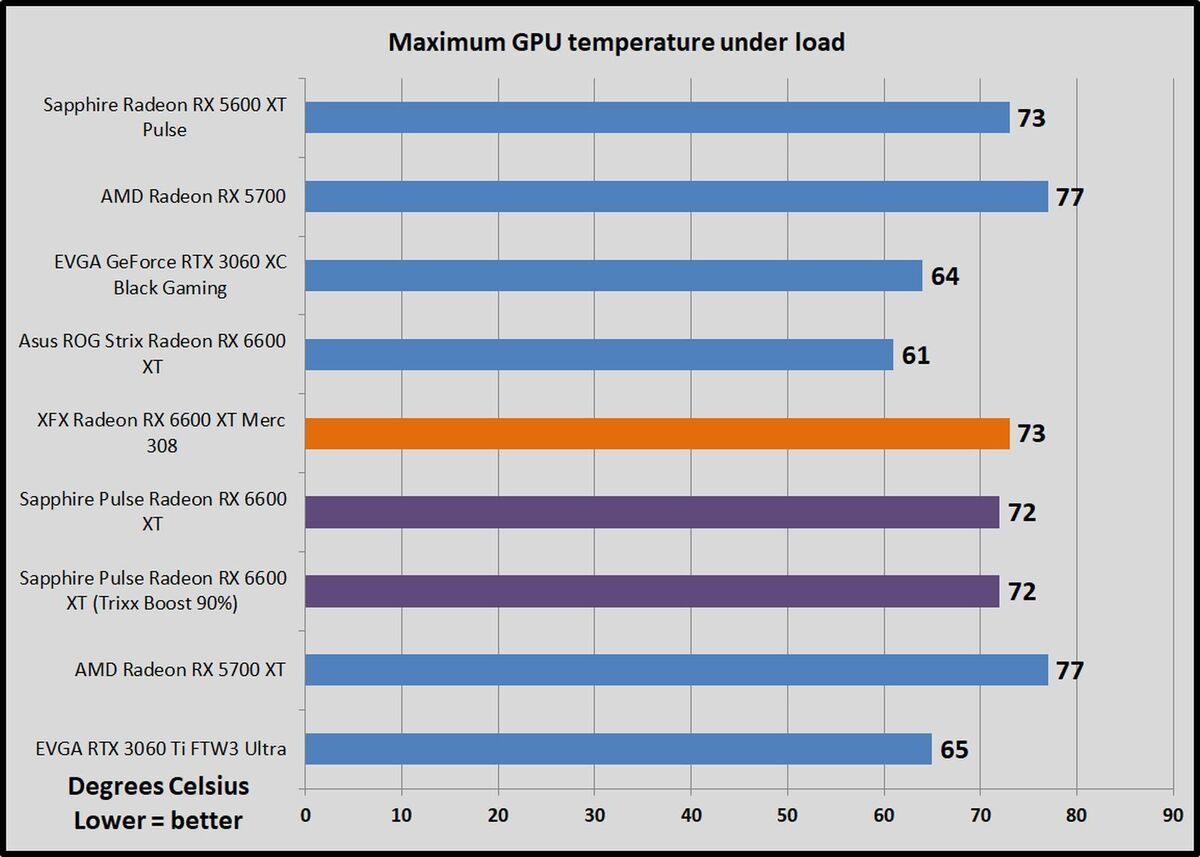 Brad Chacos/IDG
Brad Chacos/IDG Despite having a take down price and less imposing tank, the Pulsation Radeon RX 6600 XT manages to hang yob with the XFX Merc 308's wonderfully low-pitched temperatures and nearly inaudible military operation. This doesn't act like a budget ice chest some. The Asus ROG Strix achieves stunningly icy temps but does so by cranking up fan speeds, making it somewhat less pleasant to really play with than the Sapphire and XFX models.
Should you buy the Sapphire Pulse Radeon RX 6600 XT?
As I said in my initial Radeon RX 6600 XT review, most people should be avoiding buying a graphics card right forthwith. Prices remain insane while we suffer through a global chip shortage. In a vacuum, gainful $400 for a graphics card finely tuned for 1080p gaming—high refresh-rate 1080p gambling, sure, but even so 1080p gaming—feels utterly outlandish. (Trixx Supercharge helps cushion the blow, though.) That goes doubly so with the much quicker GeForce RTX 3060 Ti costing only $20 more than the 6600 XT's $379 baseline price tag. In a sane world, that would distinctly be the better option.
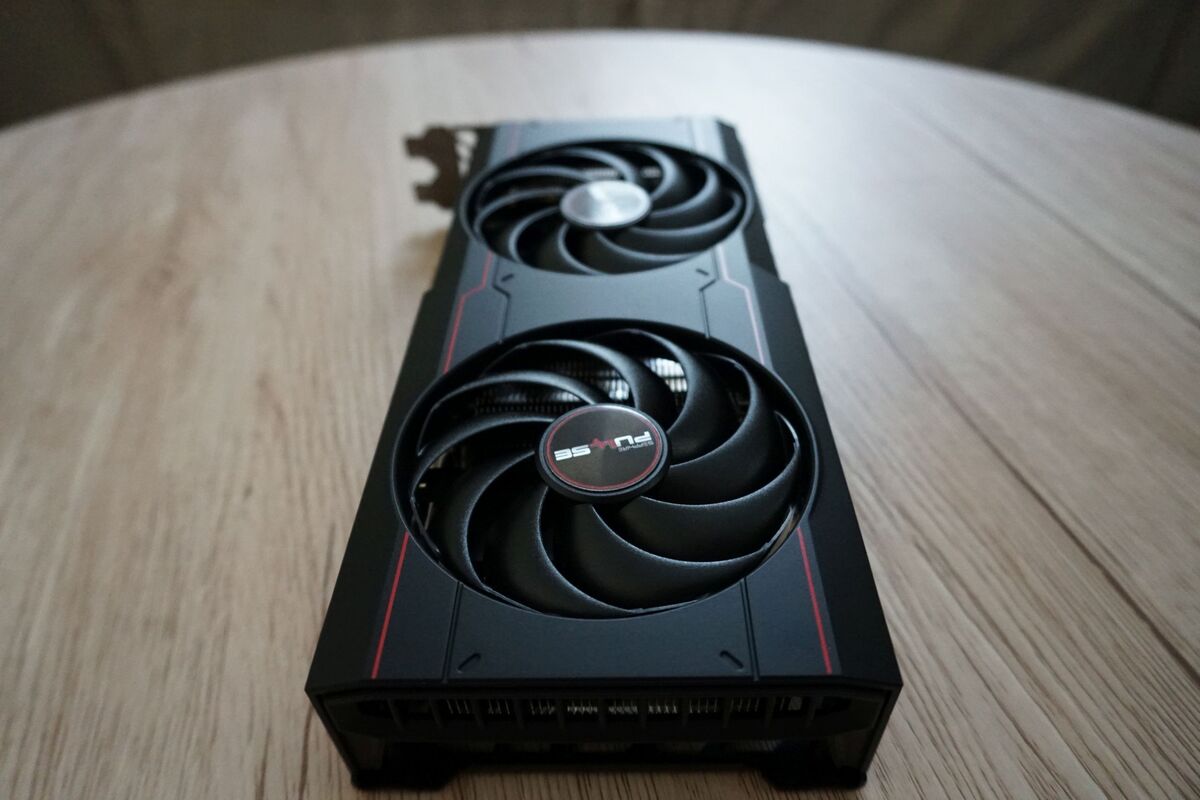 Brad Chacos/IDG
Brad Chacos/IDG But we're still living in interesting times. The GeForce RTX 3060 that the Radeon RX 6600 XT card conveniently bests is marketing for $700 or more when you can find it, scorn ostensibly being a $330 GPU. The RTX 3060 Cordyline terminalis is selling for $800 to $1,000 on Ebay right at once. Worsened, AMD's new offering showed up on resale sites for $600-plus hours after IT debuted, qualification even that too-malodorous $379 price tag look like a relative discount.
All of which is to say, if you rump sit down retired this generation, model out this genesis. Peradventur give Nvidia's GeForce Today a spin around. Hopefully things testament calm down eventually.
If you must upgrade like a sho, the Radeon RX 6600 XT delivers superbly fast 1080p gameplay for high refresh-rate monitors. That's really the foremost use case for this GPU due to its memory setup, which waterfall polish off pace a bit if you abuse up to a higher 1440p resolution.
The Sapphire Pulse's terrific Trixx Boost software helps pick up the slack thither and propels the 6600 Crosstalk's already-awesome 1080p performance to blistering new heights. This feature clay a game-changer for Lazuline—quite an literally, as it terminate get up around 60 fps in games that rivals can't at 1440p. I'm shocked that nary other ship's company has ripped IT cancelled yet. Add together Trixx; a surprisingly goody-goody ice chest; performance along a par with a great deal more expensive 6600 XT models; and a moderate (if fictitious) $20 bounty for every that, Sapphire really has crafted a winning computer software here. Sometimes linear is better.
We can't give this GPU an Editors' Select award OR a higher military rating, because paying $400 for a 1080p GPU remains penurious value. If MSRPs were real, the GeForce RTX 3060 Titanium truly would cost the none-brainer pick. But all that stuff doesn't affair if you'atomic number 75 upgrading your art card at this point one of these days. You get what you can get. And if you're looking a adequate no-frills graphics card to magnate your kick-ass high refresh-rate 1080p monitor, price be in essence unredeemed, look no further. The Sapphire Heart rate is the Radeon RX 6600 XT I'd personally buy if I were willing to spend this sort of money on a 1080p graphics card, and I'd be sure to turn on Trixx Hike.
Unexcelled Prices Nowadays

$399
Note: When you purchase something after clicking links in our articles, we may earn a small commission. Read our associate link policy for more details.
Brad Chacos spends his days digging through desktop PCs and tweeting too much.
Source: https://www.pcworld.com/article/394996/sapphire-pulse-radeon-rx-6600-xt-review.html
Posted by: carvajalyoughtley.blogspot.com


0 Response to "Sapphire Pulse Radeon RX 6600 XT review - carvajalyoughtley"
Post a Comment